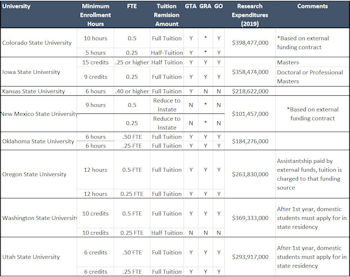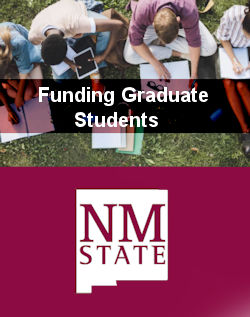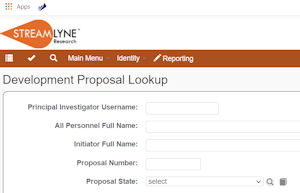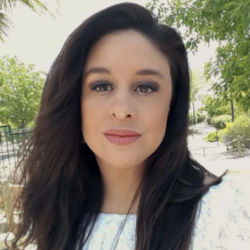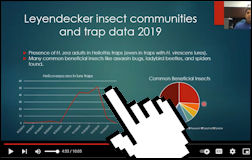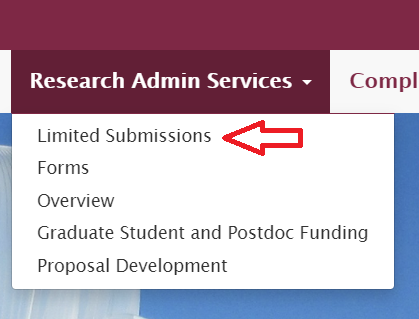 |
|||
On Tuition for Graduate Assistants
By Luis Cifuentes, Ph.D. (Vice President for Research, Creativity and Strategic Initiatives), Dennis Esquibel, Ph.D. (Associate Dean of Graduate School) and Carol Flinchbough, Ph.D. (Interim Associate Dean of Graduate School)
Including tuition in compensation packages will greatly improve graduate student recruitment, success, and well-being at NMSU. In fact, the Council of Graduate School strategic consultation report delivered in late 2018 recommended that NMSU “pay the tuition for all teaching assistants by establishing a fund to pay in-state tuition for all graduate teaching assistants. In addition, tuition for graduate research assistants should be paid by grants or external funding that currently supports the stipend.”
It is instructive to compare ourselves to aspirant peers: Colorado State University, Iowa State University, Kansas State University, Oklahoma State University, Oregon State University, Washington State University and Utah State University. These are all Carnegie R1 institutions with significantly higher (> $180,000,000) annual research expenditures than us. We must reach the goal set by the Council of Graduate School strategic consultation report. The Graduate School is working on a plan to address tuition benefits and health care costs in an incremental way, with a first step coming for next academic year. Current funds will be reconfigured to achieve these goals. Potentially, existing internal GA funding, presently supporting GA research assistants, could be replaced by external funds and repurposed for tuition remission. Finally, STEM and non-STEM research expenditures, key Carnegie R1 metrics, must be targeted for graduate student stipends, tuition, and health care and continue to grow. |
|
||
NRGCC's Hydrogen Workshop March 9, 2022
By Hamid Mansouri Rad, Senior Proposal Development Specialist, RAS
On March 9, the Office of the VP for Research, Creativity, and Strategic Initiatives (OVPRCSI) hosted a Northern Rio Grande Corridor Collaborative (NRGCC) workshop on challenges and opportunities for research and development regarding hydrogen for clean and sustainable energy. The workshop brought together more than 161 faculty and technical personnel from NRGCC members: NMSU, University of New Mexico, New Mexico Tech, University of Texas at El Paso, Los Alamos National Laboratory, and Sandia National Laboratories. The virtual event was also attended by technical staff from other National Labs and experts from industry leaders such as Energy Futures Initiative, Pajarito Powder, and Pipeline Research Council International. The plenary session of the workshop was moderated by NMSU VPRCSI Luis Cifuentes from 8:30 to noon that included presentations by
The workshop was followed by a thematic breakout sessions on related topics such as carbon capture and management. For more information about this workshop please visit the workshop’s website or contact Dr. Patricia Sullivan at patsulli@nmsu.edu, Director of the Office of Strategic Initiatives within the OVPRCSI. |
|
||
Streamlyne's System-to-System Feature
By Rita C. Parra, Director, Pre-Award Services
A significant aspect of Streamlyne is the System-to-System (S2S) functionality it provides. S2S is designed to seamlessly populate mandatory and optional proposal forms using the data collected in Streamlyne’s Proposal Development module. This functionality eliminates duplication of effort and reduces the time spent on data entry in multiple systems and/or forms. |
|
||
Recognizing NMSU's Large Proposal Submitters(February 2022)
By Hamid Mansouri Rad, Ph.D., Senior Proposal Development Specialist, RAS
Congratulations to Drs. Martha Desmond, Ramesh Chinnasamy, Mary Ulrich, Joe Song, Ramesh Chinnasamy, and Elmer Gonzalez as well as Ms. Brooke Montgomery for each submitting a proposal exceeding one million dollars in the month of February. Dr. Martha Desmond, Regents Professor of Fish, Wildlife and Conservation Ecology, submitted a $5 million proposal to NSF Scholarships in Science, Technology, Engineering and Math (S-STEM) program aiming to build a consortium of minority serving institutions across the state of New Mexico to collaboratively transform the educational experience, enhance visibility and accessibility, and increase workforce opportunities for low income, academically talented students in natural resource disciplines. For more information, please contact Dr. Desmond at mdesmond@nmsu.edu.
Dr. Mary Ulrich, the Director of Dona Ana Community College (DACC)’s Workforce Development and Career Readiness submitted a $2 million proposal to US Department of Commerce/Economic Development Administration to help address the skills gap and talent shortage in the manufacturing sector in the US by establishing the Borderlands Workforce Training Center and Innovation Hub, creating a robust sectoral partnership in manufacturing, transportation, and warehousing. The goals of the Center include dynamically engaging regional employers in sectoral partnership to create a skilled workforce, redesigning existing training programs into short-term, fast-paced training with concurrent English language skills and developing new training programs based on employer needs. For more information, please contact Dr. Ulrich at mulrich@nmsu.edu.
Dr. Joe Song, Professor of Computer Science and Molecular Biology & Interdisciplinary Life Sciences, submitted a proposal to the National Institutes of Health for $2 million to use model-free data science methodologies to expedite single-cell biology research to reveal disease mechanisms needed for clinical applications. The proposal was developed based on preliminary results generated by outstanding doctoral students Sajal Kumar, Ruby Sharma, and Lovemore Tenha, recipients of Graduate Assistant Tuition Scholarship for New Graduate Students, Merit-based Enhancement Award, and Outstanding Graduate Assistantship Award, respectively. The envisioned project will dissect gene networks involved in accelerated tumor development caused by a genetic mutation. For more information please contact Dr. Song at joemsong@cs.nmsu.edu.
Dr. Ramesh Chinnasamy, College Assistant Professor of Chemistry and Biochemistry, submitted a proposal to NSF S-STEM program requesting $1.5 million to recruit 20 academically talented low-income underrepresented minority and first generation college undergraduate students majoring in Chemistry and Biochemistry. The proposed project will also provide academic support in form of mentoring by a group of NMSU faculty mentors, tutoring and providing access to supplemental classes. The project will also provide internship opportunities, a summer boot camp, exposure to invited talks, and hands-on research projects. Dr. Chinnasamy can be reached at ramesh@nmsu.edu.
Dr. Elmer Gonzalez, the Director of the Dona Ana Community College Dental Hygiene Program submitted a $1.5 million proposal to the US Department of Health and Human Services to address the oral health disparities in Southern New Mexico by educating and training pre-doctoral dental, dental hygiene, and other oral health care trainees. The proposed effort will also provide care for populations with medically complex conditions, special health care and behavioral health care needs, and incorporate the Social Determinants of Health into clinical care. Dr. Gonzalez can be reached at elmer6@nmsu.edu.
Brooke Montgomery, Director of Arrowhead Center’s Studio G, submitted a $1.2 million proposal to USDA NIFA to deliver entrepreneurial, innovation, and agricultural-related educational curricula and technical assistance to New Mexico youth in four school districts in NM. The proposed project is in collaboration with Indian Resources Development and Cooperative Extension Service with Navajo Technical University’s Land Grant Program and seeks to enhance availability and accessibility of educational resources used to encourage youth to become positive, productive, and contributing members of our communities.
|
Dr. Martha Desmond, NMSU Dr. Mary Ulrich, DACC, NMSU |
||
Can Plant Architecture and Eastern New Mexico’s Semi-arid Environment Control Insect Pests?Program Manager, Agricultural Experiment Station Administration, College of ACES
Increasing resistance to insecticides and plant protection genes will challenge growers and entomologists to find alternative means to control insect pests. Fortunately, eastern New Mexico has resources that can be developed into tools to suppress insect pests. Eastern New Mexico is the most agriculturally rich area of New Mexico producing $1.8 Billion in Agricultural Gross receipts, almost 60% of the $3.2 Billion for New Mexico, so investments in crop protection research have large potential returns. To address this challenge, Dr. Jane Pierce, a research/extension entomologist at the Agricultural Research Center in Artesia and a faculty member of the Departments of Entomology, Plant Pathology and Weed Science and Extension Plant Sciences, along with her team is evaluating and developing tools for insect pest management, taking advantage of the region's semi-arid environment, diverse cropping systems and relatively high populations of natural enemies. This video illustrates a project conducted by her graduate student, Ivan Tellez, evaluating the value of breeding plants with architectural traits that increase desiccation of insect pests. Late season, conventional cotton canopies are highly dense, allowing higher survival, potential for outbreaks and economic losses. Reductions in egg hatch can suppress populations and avoid such outbreaks. Funding for this project includes support by Cotton Incorporated, Cotton Foundation, and the New Mexico Agricultural Experiment Station. Dr. Pierce can be reached at apierce@nmsu.edu. |
Dr. Jane Pierce, NMSUClick to view. |
||
Proposal Writing in the Arts and HumanitiesBy Cindy Ramirez, Proposal Development Specialist, RAS
Research Administration Services will hold a proposal writing webinar in the Arts and Humanities at 1:00pm on Friday March 25. Offered by Dr. Hamid Mansouri Rad, Senior Proposal Development Specialist, this webinar will touch on basic topics such as proposal cycle at NMSU, proposal writing fundamentals, locating funding opportunities and strategies to develop competitive proposals. Those interested should send an email to hamid@nmsu.edu. |
|
||
Limited Submission Funding OpportunitiesBy Hamid Mansouri Rad, Ph.D., Senior Proposal Development Specialist, RAS
Research Administration Services maintains a list of limited submission funding opportunities for NMSU research community. The list is accessible through a link on the Research website, through the Research Administration tab. NMSU users can also access the list directly on SharePoint. We encourage NMSU researchers to periodically visit the site and if they are interested in any of the opportunities to please inform us by sending email to ras@nmsu.edu. |
|
||
Pivot Funding Opportunity Database
By Hamid Mansouri Rad, Ph.D., Senior Proposal Development Specialist, RAS
This is a reminder that in order to assist NMSU faculty and staff in locating external funding opportunities, the OVPRCSI has purchased a subscription to ProQuest’s Pivot available at https://pivot.proquest.com/session/login.
To request a one-on-one or group Pivot training, send email to hamid@nmsu.edu. |
|
||
Graduate School |
|||
Graduate Student Scholarships for FY 22-23
By Carol Flinchbaugh, Ph.D., Associate Professor of Management and Interim Associate Dean, Graduate School
Notification for graduate student tuition success scholarships, diversity scholarships, and merit and outstanding graduate assistant awards were sent to Academic Deans and Department Heads. Please reach out to your areas for more information. The Graduate School will be sending out nominations for the Preparing Future Faculty and NM Higher Education Department awards in the next two weeks. Please reach out to gradinfo@nmsu.edu with any questions. |
|
||
Questions and comments regarding NMSU’s Research Digest should be directed to Hamid Mansouri Rad, Ph.D. at hamid@nmsu.edu, (575) 646-6429. |
|||

